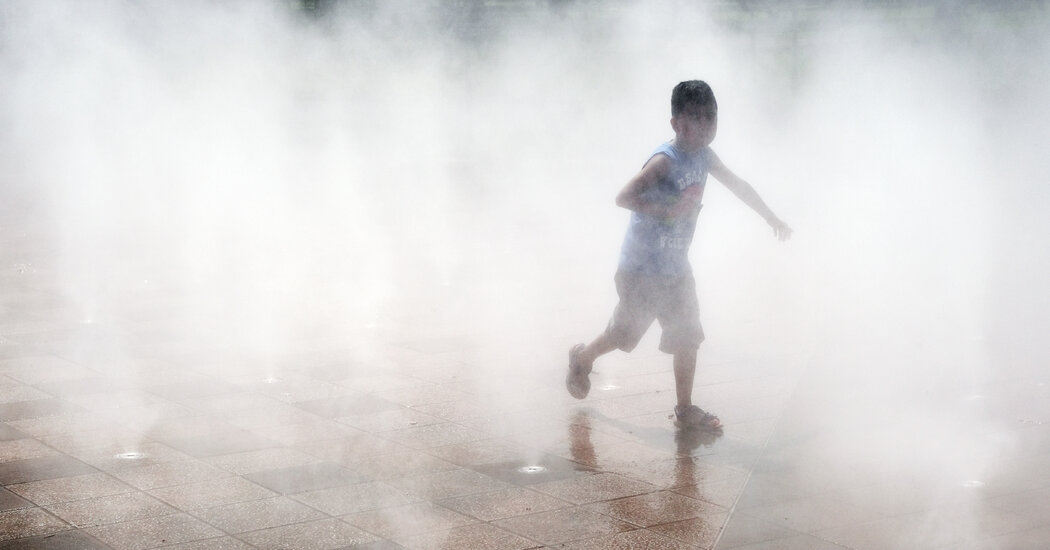The first nationwide study on rising temperatures and younger Americans found that hotter days were associated with more visits to emergency rooms.
Hotter temperatures in late spring and summer were associated with higher rates of emergency-room visits for children across the United States, researchers said Wednesday.
The research adds to a growing body of evidence of the dangers that heat poses to vulnerable populations, including children and adolescents. Although children dissipate heat in the same way as adults, they suffer the effects differently, in part because of differing body surface areas, body fat composition and hydration.
“We’ve run into trouble previously assuming that children are little adults,” said Dr. Aaron Bernstein, a pediatrician at the Boston Children’s Hospital who was one of the paper’s authors. But the findings show that their bodies suffer from some unique effects of heat.
The research, published Wednesday in Environmental Health Perspectives, is the first to offer a comprehensive study on the effects of rising temperatures on people 18 and under across the country. The authors analyzed data from nearly four million emergency department visits at 47 children’s hospitals nationwide in late spring and summer between 2016 and 2018.
They found that nearly 12 percent of those emergency department visits could be attributed to elevated temperatures. But those rates were much higher for certain conditions. Nearly a third of emergency department visits for heat-related illness, like heat stroke and heat exhaustion, and a quarter of the visits for bacterial intestinal infections, were attributed to heat.
Dr. Bernstein said that some of the infections that peaked in the summer could be associated with changes in behavior caused by the warm weather. For instance, higher rates of ear infections could be a result of more time spent in swimming pools, and bacterial intestinal infections could be a result of picnicking or eating foods that had been removed from refrigeration.
But a number of the findings surprised researchers. For instance, the increased risk for children suffering from blood, immune and nervous-system diseases during periods of higher heat are not easily explained by changes in behavior and have not been seen in studies of adults.
With climate change, heat waves and rising temperatures are becoming more frequent. And that has repercussions for human health.
It is well established that days of extreme heat are dangerous for adults and can lead to excess deaths, particularly in vulnerable populations like older people. When temperatures rise, people can become severely ill or die if they are unable to effectively sweat and cool off. This can lead to an increase in internal body temperature.
Understand the Latest News on Climate Change
A warming trend. European scientists announced that 2021 was Earth’s fifth hottest year on record, with the seven hottest years ever recorded being the past seven. A Times analysis of temperatures in the United States showed how 2021 outpaced previous years in breaking all-time heat records.
In addition to temperature-related illnesses like heat strokes or heat exhaustion, adults can also suffer cardiovascular and respiratory disorders. Last summer, a New York Times analysis found that the deadly heat wave in the Pacific Northwest resulted in 600 more deaths than would have been typical.
“We know that, due to climate change, days with extreme heat are going to be more frequent and more intense,” said Francesca Dominici, a biostatistician at Harvard’s T.H. Chan School of Public Health who has studied the effects of extreme heat on human health and was not involved in the new research. “The degree to which children are susceptible to climate change risk, it should be a high priority for scientists to study.”
One reason it is important to study children is because of the possibility of lifelong effects. “The question of which of these diseases that manifest on a hot day are completely curable with proper intervention and which may create chronic disease later in life, is a very open research question,” Dr. Dominici said.
Dr. Dominici added that this research could make clinicians and parents more aware of the range of disorders that affect children during hotter temperatures. “If we know what types of diseases might be exacerbated on these days in kids, we can either prevent these diseases or when kids come into the E.D. clinicians are knowledgeable about what’s happening.”
Dr. Bernstein said the research underscored the inequities in pediatric health care. For instance, though a quarter of all bacterial intestinal infections were attributed to heat, those rates were substantially higher for nonwhite children and those who rely upon public health insurance like Medicaid. The data, which did not include pediatric visits to community hospitals or primary care appointments, reiterated that “children without good access to care are more likely to use an emergency department,” he said.
“It’s one thing when we see these inequities laid bare in people at the end of life,” Dr. Bernstein said. But for a child, “we essentially put them on a different course for the rest of their life.”


























